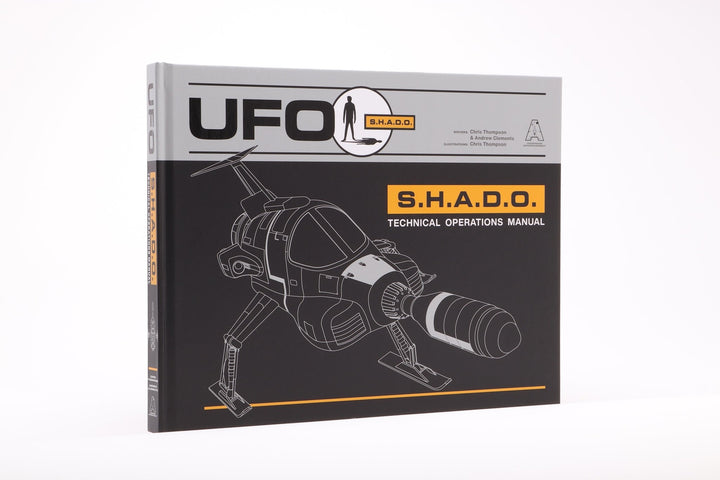Thunderbirds Thursday: Investigating the Thunderbird 6 Prototypes

Thunderbirds' television lifespan was unexpectedly cut short when the hugely expensive series failed to take off in the lucrative American TV market, whilst the damp box office reception of both of its feature films, Thunderbirds Are Go and Thunderbird 6, didn't entirely help matters. Nevertheless, International Rescue's final original screen-based adventure pushed the series' format into intriguing directions by expanding on International Rescue's core fleet of rescue vehicles, which sadly never came to further fruition with additional films or TV episodes. In Thunderbird 6, the star-spinning adventures of Zero X are swapped out for a decidedly lighter, less hardware-heavy story focusing on the villainous Black Phantom's efforts to sabotage the maiden voyage of Brains' latest invention - Skyship 1.
Whilst Lady Penelope, Tin Tin, Alan and Parker contend with the duplicitous crew of the Skyship 1, who patiently lay a trap involving securing various spoken sentences by Lady Penelope to transform them into a fake message to lure the Thunderbirds into disaster, Brains endures troubles much closer to home. The International Rescue scientist has been tasked by Jeff Tracy to build an entirely new Thunderbird craft, and spends much of the film having his ingenious design ideas turned down. Brains would gain the upper hand by the film's end by utilising a hugely unconventional machine to become the latest addition to International Rescue's craft, but the prototypes he presents to Jeff offer a delightful insight into how the Thunderbirds could have expanded their fleet. On this Thunderbirds Thursday, we're investigating just what those prototypes were!
Flame On!

During the film, Brains presents the Tracy family with a trio of eye-catching contenders to become the new Thunderbird 6. The first of these is a yellow, ground-based vehicle designed to rescue victims trapped in burning buildings via a balloon-aided winch system. This prototype has the advantage of being the only one which we actually see Brains demonstrate, so we have a pretty clear-cut idea of its functionality and purpose - and why it's perhaps not the strongest candidate to be Thunderbird 6.
Thunderbird 6's bears some admittedly awkward characterisation for its heroes, particularly in that Jeff never presents Brains with any clear specification as to what he actually wants from a sixth Thunderbird vehicle. But it's only during this demonstration that Jeff offers a pretty solid reason for why Brains' first prototype won't suffice. This firefighting version of Thunderbird 6, whilst impressive in design, only boasts a single function. This puts this design much more in line with being a pod vehicle, rather than one of the core Thunderbirds, all five of which bear multi-faceted capabilities. Why this version of Thunderbird 6 couldn't be repurposed into a pod vehicle is never touched on on the film, however. Clearly, Jeff is a tough customer! But then again, Jeff has a point. As a land-based vehicle, it's limited in what it can achieve and would surely be redundant without Thunderbird 2 being able to transport it to the danger zone.
Behind-the-scenes, we may safely presume that this, and the other two prototypes of Thunderbird 6, were designed by Derek Meddings, who also designed the main five Thunderbird craft. It's certainly a formidable design, bearing chunky caterpillar tracks at the vehicle's front and what appear to be adjustable and gargantuan rear wheels, presumably to allow the craft to traverse any sort of formidable terrain. The prototype looks as if it would have had a least two operators required - one to drive the machine from within the cab and one to operate the balloon platform at the back of the vehicle. A pair of bug-like protruding floodlights at the front also suggest this vehicle would come in handy during night-time rescues, a surprising rarity in the original series. However, this yellow Thunderbird 6 wouldn't be chosen, prompting Brains to conjure up further ideas.
A Silver Surfer?

Brains' second stab at creating a prototype for Thunderbird 6 is arguably the most visually arresting. We're not shown any demonstrations of what this aircraft is meant to add to the International Rescue fleet, but its design offers some tantalising possibilities. With its front-focused jet intakes and rear wingspan, it visually echoes some of the hallmarks of Thunderbird 2. However, it packs in some unusual yet telling design features. The multitude of radar prongs at the craft's front and permanently fixed, pincer-like landing gear suggests that Brains must have taken Jeff's advice to heart and designed something with more diverse abilities.
It's not the most aerodynamic in appearance, but perhaps that's partly the point? As well as carrying over some of Thunderbird 2's aesthetic, the landing gear of this Thunderbird 6 is reminiscent of the various hovercraft vehicles seen throughout the series. Maybe then this Thunderbird 6 was designed for low-altitude missions in which the wide bulk of Thunderbird 2 or the limited abilities of Thunderbird 1 wouldn't prove useful. With its claw-like landing gear and implied radar detection features, perhaps this take on Thunderbird 6 might be utilised for tracking victims trapped in enclosed spaces which would be difficult for any conventional aircraft to reach. Jagged mountain edges or active volcanos rather spring to mind, environments where it's tricky to envision other core Thunderbirds to navigate. Whatever this take on Thunderbird 6 was meant to offer, it still wouldn't appease Jeff's cryptic demands...
It's a Rocket! It's a Plane! It's... Something!

The third and final Thunderbird 6 prototype built by Brains is surely the least decipherable. At least with the silver Thunderbird 6 we can immediately see that it's some manner of aircraft. But this? This?! The first thing that strikes you about this third attempt at Thunderbird 6 is just how long it is. Evidently then, it could be some kind of single-stage-to-orbit rocket, but those exposed cockpit canopy windows upfront don't inspire confidence. Would you want to sit in one of those hurtling towards the stars at maximum escape velocity?
Or perhaps it's meant to be less of a rocket, and more of a spaceplane; a craft that combines the manoeuvrability of travelling like an aircraft in Earth's atmosphere and like a spacecraft in outer space. Thunderbird 3 is clearly designed for exclusively deep-space rescue, so perhaps that leaves a noticeable gap in International Rescue's technology to allow for a machine which is able to easily traverse both sky and space. The most obvious real-world example of this is NASA's now retired Space Shuttle system, and concepts for spaceplane craft had been in use since the 1950s. In that case, perhaps this version of Thunderbird 6 took some real-world inspirations?

But then again, it's difficult to envision that restrictively rectangular body being of any use in the clouds or the stars. The lack of any tangible wingspan, save for some lower-positioned fins, looks rather suspect. Maybe then this Thunderbird 6 could make a decent pass as another submarine vehicle for International Rescue. This prototype's lengthily form feels better suited to surging through the depths of the world's oceans. Thunderbird 4 proved its versatility time and time again across the series, but as a vehicle, it's always been on the smaller end of the vehicular spectrum, and as 'Terror in New York City' highlights, it's not the most reliable Thunderbird for speed.
If this red proposed incarnation of Thunderbird 6 could be utilised for underwater purposes, it sure does look like speed wouldn't be an issue. Perhaps it wouldn't even need to rely on Thunderbird 2's transportation, and therefore invites a whole new realm of possibilities as to how this vehicle would launch from Tracy Island. This bulked-out yet smooth and streamlined potential submarine would surely make a handsome companion to the compact TB4 - there's no reason you couldn't have both performing in the same rescue operation, providing tactical support to each other in the same way as Thunderbirds 1 and 2 often do. Additionally, a second sea-faring I.R. vehicle would allow a welcome expanse of the organisation's underwater rescuing abilities.
But alas, the vehicle that would become Thunderbird 6, whilst an amusing visual gag to end the film on, remains an anticlimactic reveal. A Tiger Moth biplane struggles to gel with the technologically advanced nature of the Thunderbird machines and feels all too close to a real-world vehicle, when part of the purpose of International Rescue is to prioritise having rescue technology which the rest of the world lacks. Behind the scenes, it's also likely that the silver and red prototype vehicles were designed without a purpose in mind, since they don't feature within the film's plot, leaving their imaginative designs all the more intriguing for us to pour over. We can only imagine at the types of renewed adventures Thunderbirds may have enjoyed if any of Brains' proposed takes on Thunderbird 6 could have made it into Supermarionation reality!




![Thunderbirds Comic Anthology Volume One [HARDCOVER] - The Gerry Anderson Store](http://gerryanderson.com/cdn/shop/files/thunderbirds-comic-anthology-volume-one-hardcover-8030771.jpg?v=1751089031&width=720)
![All Sections Alpha: The Making of Space: 1999 [HARDCOVER] - The Gerry Anderson Store](http://gerryanderson.com/cdn/shop/files/all-sections-alpha-the-making-of-space-1999-hardcover-7498116.png?v=1757766647&width=720)

![Stingray Comic Anthology Volume Two – Battle Lines [HARDCOVER] - The Gerry Anderson Store](http://gerryanderson.com/cdn/shop/files/stingray-comic-anthology-volume-two-battle-lines-hardcover-107681.jpg?v=1738856151&width=720)
![Stingray W.A.S.P. Technical Operations Manual Standard Edition [HARDCOVER] - The Gerry Anderson Store](http://gerryanderson.com/cdn/shop/files/stingray-wasp-technical-operations-manual-standard-edition-hardcover-112278.jpg?v=1749664163&width=720)
![Stingray WASP Technical Operations Manual Special Limited Edition [HARDCOVER BOOK] - The Gerry Anderson Store](http://gerryanderson.com/cdn/shop/files/stingray-wasp-technical-operations-manual-special-limited-edition-hardcover-book-991914.jpg?v=1749657538&width=720)
![Stingray: The Titanican Stratagem – Signed Limited Edition [HARDCOVER NOVEL] - The Gerry Anderson Store](http://gerryanderson.com/cdn/shop/files/stingray-the-titanican-stratagem-signed-limited-edition-hardcover-novel-129251.jpg?v=1740558711&width=720)







